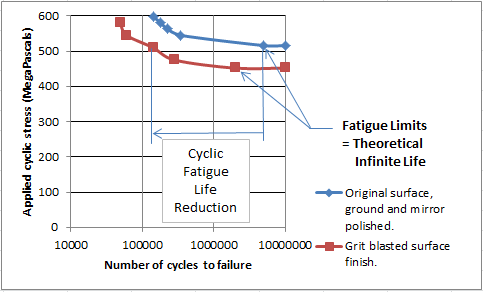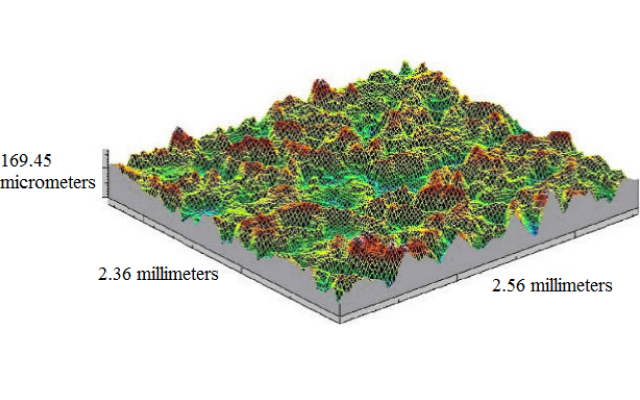Contributor: Robert A. Leishear, PhD, P.E. leishearengineeringllc.com
Since the 1970’s, the uses of high performance coatings have exponentially increased to fend off corrosion, but the experts have overlooked the fact that surface preparations shorten the expected life of piping systems, where cyclic fatigue life is diminished by grit blasting.
Coating technology evolved and its effects were overlooked by those responsible. On the one hand, corrosion engineers exercised due diligence to ensure that coatings properly adhere to surfaces to minimize corrosion damages. On the other hand, structural engineers exercised due diligence to ensure effective structural design and piping design. However, this new discovery fell through the cracks.
Different groups of experienced engineers work to stringent standards to ensure competent and safe designs. Piping engineers work to ASME (American Society of Mechanical Engineers) Standards; corrosion engineers work to NACE and SSPC (National Association of Corrosion Engineers and the Society of Protective Coatings) standards for coatings and preparations, and structural engineers work to ASCE (American Society of Civil Engineers) Standards. This new discovery fell through the cracks.
The structural and piping engineers are not corrosion or coating experts, and they did not
consider the effects of surface preparations with respect to the life of the components. The corrosion engineers are not materials experts, and they did not consider the effects of surface preparations with respect to the life of the components. This new discovery fell through the cracks.
Volunteer Research
First, consider how this discovery was uncovered – through hard work and study. As part of continuing volunteer research on piping ruptures and explosions, a $20,000 series of NACE corrosion classes were attended by this author to better understand piping cracks. This corrosion research was part of a multi-year, $100,000, volunteer, research effort to explain pipeline explosions, pipeline ruptures, water main breaks, and nuclear power plant explosions, where all of these accidents and catastrophes are interrelated by a common cause – fluid transients. This statement may, at first, seem questionable, but more than twenty thousand hours have been invested into this research over twenty years, and an ASME textbook and numerous publications document these facts from an invented, one-man, common-mode theory, i.e., “Fluid Mechanics, Water Hammer, Dynamic Stresses, and Piping Design”, ASME Press textbook by R. A. Leishear; and “The Spark that Ignited Three Mile Island Burst from a Safety Valve, ASME Magazine, by R. A. Leishear. As part of 40 publications on fluids, structures, and explosions, this series of publications focused on the mechanics of accidents and catastrophes, where this theory explains 13 million dollars a year in U.S. water main breaks, and this fluid transient theory explains the explosion causes for nuclear power plant accidents to include Fukushima, Three Mile Island, and many other smaller explosions. However, corrosion needed further study to better understand oil pipeline ruptures, since there are numerous corrosion causes of failure to be considered along with pipeline cracking for pipelines.
Accordingly, corrosion studies were attended at the NACE training center in Houston, where surface preparations were considered, and a major discovery was made. Grit blasting was known to be used for coating adherence, but no one had previously noticed that the fatigue life, or time to failure, was decreased due to grit blasting. This observation may seem simple, but this new discovery fell through the cracks.
During classes, surface profiles and testing methods were considered for grit blasting. Hardly accidental, the author noted that these required surface profiles would obviously decrease fatigue properties of any grit blasted surface. This observation was obvious due to many years Graduate School studies, which included fatigue and fracture mechanics of materials, in addition to previous experience as a welder and painter. Decades of night school studies fell into place. If these classes had not been attended, this new discovery would have fallen through the cracks again. Again, this discovery may seem rather simple in nature, or even seem accidental, but this discovery passed by thousands of engineers over the past decades, and this discovery can no longer slip through the cracks.
A New Discovery
Now, consider the facts of this new discovery. Sand blasting procedures propel high velocity particles against surfaces to effectively clean those surfaces. Specifically, sand blasting is a primary tool to ensure that high performance coatings stick to surfaces better. Even so, blasting is not used in all cases. There are two types of sand blasting, i.e., shot blasting and grit blasting. On the one hand, shot blasting blasts rounded particles against surfaces, which dent the surfaces to be cleaned, where shot blasting hardens the surface and actually increases fatigue life. On the other hand, grit blasting blasts irregular, sharded particles against a surface to abrade, or rip, that surface to provide sharp profiles to better adhere applied coatings. Both types of blasting are used, but grit blasting is a primary type of blast for coating preparations, since it offers better adherence, of course. However, grit blasting decreases the fatigue properties.
Fatigue Life, Cycles to Failure
Fatigue curves predict the number of cycles to failure for a given stress. Designers use
fatigue curves to predict the expected life of piping and structures, like bridges. This author has used fatigue curves from various ASME Codes for both new design and for troubleshooting failures on existing piping designs. In particular, the author has evaluated water main breaks due to fatigue, where the American Water Works Association expects a trillion dollars in water main breaks in the next 25 years. While proving that fluid transients, or water hammers, are the primary cause for these failures, the author has a gut feel that existing fatigue curves did not explain the rate of water main breaks. Qualitatively, coated water mains seemed to break earlier than expected. Something caused premature failures, but that “something” was not obvious.
Back to the NACE classes – stress raisers due to grit blasting obviously defined that
“something” that was needed to better explain water main breaks. A brief literature review showed that there was scant published data available, but there was a well written article on the fatigue of 4140 steel that was subjected to grit blasting. The conclusion was certain. Grit blasting reduced the number of cycles to failure by a factor of more than 30 in some cases. Note that the fatigue limit is the number of cycles beyond which ongoing cyclic stresses will not cause cracks, or failures. The proof is conclusive. Grit blasting significantly reduces fatigue life. Again, this discovery can no longer slip through the cracks.

4140 Steel, Fatigue Changes due to Grit Blasting
(Adapted from “Fatigue Behavior of a 4140 Steel Coated with a NiMoAl Deposit Applied by HVOF Thermal Spray”, Oadilla, Velasquez, Berrios, and Caberra, Elsevier Press, 2002)
What is Next?
The scope of the problem needs to be defined, where all piping and structures are not
subjected to fatigue cycling, all structures are not grit blasted, and fatigue data is required for materials other than 4140 steel to determine the grit blast effects for each material. Design margins, called safety factors decades ago, may be sufficient in many cases to ensure safety of many existing designs. However, the hundreds of thousands of water main breaks per year in North America, the ongoing pipeline ruptures in the oil and gas industry, and ongoing piping damages in nuclear power plants do not fall into this category.
The scope of this problem is not fully known at present, since this writing is the first public announcement of this discovery – seems appropriate to call this technological breakthrough the Leishear Fatigue Theory. Action needs to be taken to perform additional research to change international Codes and Standards, which inadequately address this world wide problem. In the bridge and building industry, the scope of this problem is yet to be determined since this research is new. In the water industry, water main breaks can be stopped. In the nuclear industry and other piping industries, costly damages can be curtailed, where most piping cracks are caused by water hammer and lowered fatigue properties, even though vibrations and other causes contribute to some cracks. In the oil and gas pipeline industry, deaths and environmental disasters will continue until this fatigue problem and the parallel fluid transient problem are incorporated into Codes and Standards.
This discovery is no longer between the cracks, and corrective actions cannot be allowed to fall through the cracks. The stakes are too high.
Water Main Failures due to Water Hammer: a Billion-Dollar-a-Year Problem




